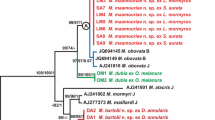Abstract
Examination of specimens collected from water shrews Neomys fodiens in the Rhodope Mountains, Bulgaria, revealed a new species of Soricinia. Soricinia genovi n. sp., is described and the syntype of Soricinia globosa (the only other Soricinia species known from Neomys) is redescribed. The new species differs from S. globosa in the number of proglottids, relative length of the cirrus-sac, number of eggs in gravid proglottids, absence of vaginal sphincter and other characters. Among Soricinia, parasitic in shrews of the genus Sorex, the new species is most similar to Soricinia quarta. Soricinia genovi can be distinguished from S. quarta by the length of the cirrus-sac, larger testes and ovary, position of vitellarium and armament of cirrus. Comparison of nuclear ribosomal 28S DNA sequences and mitochondrial nad1 sequences clearly distinguishes S. genovi sp. n. from S. quarta, Soricinia bargusinica and Soricinia infirma. The levels of interspecific sequence divergence among Soricinia species exceed those reported for some other hymenolepidids of mammals. Phylogenetic analysis places S. quarta and S. genovi sp. n. as the closest taxa which is in agreement with morphological evidence. Our data suggest that the specimens of Soricinia from the Altai Mountains that were morphologically closest to S. infirma represent a new species. Pairwise sequence comparisons and phylogenetic analysis also indicate that “S. infirma” group may constitute a genus separate from the remaining Soricinia.





Similar content being viewed by others
References
Baer JG (1925) Cestodes de mammiferes. Bull Soc Neuchatel Sci Nat 50:77–81
Baer JG (1931) Helminthes nouveaux parasites de la musaraigne d’eau, Neomys fodiens Pâli. (Note préliminaire). Verh Der Schweizerischen Naturforschenden Ges 112:338–340
Binkienė R, Kontrimavichus V, Hoberg EP (2011) Overview of the cestode fauna of European shrews of the genus Sorex with comments on the fauna in Neomys and Crocidura and an exploration of historical processes in post-glacial Europe. Helminthologia 48:207–228. doi:10.2478/s11687-011-0031-5
Czaplinski B, Vaucher C (1994) Family Hymenolepididae Ariola, 1899. In: Khalil RA, Jones LF, Bray A (eds) Keys to the cestode parasites of vertebrates. CAB International, Wallingford, pp 595–663
Genov T (1984) Helminths of insectivores and rodents in Bulgaria. Publishing House of the Bulgarian Academy of Sciences, Sofia
Greiman SE, Tkach VV (2012) Description and phylogenetic relationships of Rodentolepis gnoskei n. sp. (Cyclophyllidea: Hymenolepididae) from a shrew Suncus varilla minor in Malawi. Parasitol Int 61:343–350. doi:10.1016/j.parint.2012.01.003
Hall T (1999) BioEdit: a user-friendly biological sequence alignment editor and analysis program for Windows 95/98/NT. Nucl Acids Symp Ser 41:95–98
Haukisalmi V, Hardman LM, Foronda P, Feliu C, Laakkonen J, Niemimaa J (2010) Systematic relationships of hymenolepidid cestodes of rodents and shrews inferred from sequences of 28S ribosomal RNA. Zool Scr 39:631–641. doi:10.1111/j.1463-6409.2010.00444.x
Hutterer R, Meinig H, Bertolino S et al (2008) Neomys fodiens. IUCN red list of threatened species. Version 2013.1. International Union for Conservation of Nature. http://www.iucnredlist.org/details/29658/0
Karpenko SV (1983) Two new hymenolepid cestodes species of shrews from Baikal-Amur pathway. Izv Sib Otd AN SSSR 2:125–132
Karpenko SV (1999) Cestodes of the genus Soricinia from Holarctic region shrews. Zool Zh 78:922–928
Littlewood D, Waeschenbach A, Nikolov P (2008) In search of mitochondrial markers for resolving the phylogeny of cyclophyllidean tapeworms (Platyhelminthes, Cestoda)—a test study with Davaineidae. Acta Parasitol 53:133–144. doi:10.2478/s11686-008-0029-4
Mas-Coma S, Puchades MT (1991) A methodology for the morphoanatomic and systematic study of the species of the family Hymenolepididae Railliet et Henry, 1909 (Cestoda: Cyclophyllidea). Res Rev Parasitol 51:139–173
Mituch J (1968) Index helminthum. Studia Helminthologoca 2:220–341
Posada D (2008) jModelTest: phylogenetic model averaging. Mol Biol Evol 25:1253–1256. doi:10.1093/molbev/msn083
Prokopič J (1959) The parasitic helminths of Insectivora in ČSR. Československa Parasitol 6:87–134
Prokopič J, Karapchanski I, Genov T, Janchev J (1974) Ecological analysis of the helminth fauna of the small mammals in different biotopes and different regions of Europe. Izv Na Tsentralnata Khelmintologichna Laboratoriya 17:119–144
Rambaut A (2012) Molecular evolution, phylogenetics and epidemiology. FigTree ver. 1.4 software. http://tree.bio.ed.ac.uk/software/figtree/
Ronquist F, Huelsenbeck JP (2003) Bayes 3: Bayesian phylogenetic inference under mixed models. Bioinforma 19:1572–1574
Spassky AA, Spasskaja LP (1954) Systematics of Hymenolepididae parasitizing of birds. Trudy Gel’mintologicheskoi Laboratorii Akad Nauk SSSR 7:55–119
Tkach VV, Makarikov SA, Kinsella JM (2013) Morphological and molecular differentiation of Staphylocystis clydesengeri n. sp. (Cestoda, Hymenolepididae) from the vagrant shrew, Sorex vagrans (Soricomorpha, Soricidae), in North America. Zootaxa 3691:389–400
Tkach V, Pawlowski J (1999) A new method of DNA extraction from the ethanol-fixed parasitic worms. Acta Parasitol 44:147–148
Žarnowski E (1955) Robaki pasozytnicze drobnych ssakow lesnych (Rodentia i Insectivora) okolicy Pulaw (woj. lubelskie). I. Cestoda. Acta Parasitol Pol 3:279–368
Acknowledgments
We thank Boyko Georgiev and Yasen Mutafchiev (Institute of Biodiversity and Ecosystem Research Bulgarian Academy of Sciences) who kindly helped with the collection of cestodes in Bulgaria. We are also grateful to Arseny Makarikov (Institute of Systematics and Ecology of Animals, Russian Academy of Sciences) for providing a specimen of Arostrilepis beringiensis for the molecular study. This study was funded in part by the Russian Fund for Fundamental Research (Project Nos. 14–04–00871–a) for SAK and the National Science Foundation Planetary Biodiversity inventory program (grant DEB 0818696) for VVT.
Author information
Authors and Affiliations
Corresponding author
Rights and permissions
About this article
Cite this article
Binkienė, R., Kornienko, S.A. & Tkach, V.V. Soricinia genovi n. sp. from Neomys fodiens in Bulgaria, with redescription of Soricinia globosa (Baer, 1931) (Cyclophyllidea: Hymenolepididae). Parasitol Res 114, 209–218 (2015). https://doi.org/10.1007/s00436-014-4180-6
Received:
Accepted:
Published:
Issue Date:
DOI: https://doi.org/10.1007/s00436-014-4180-6




